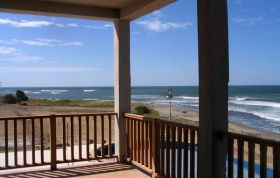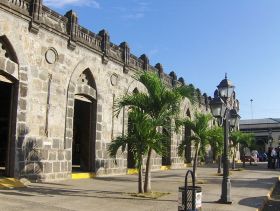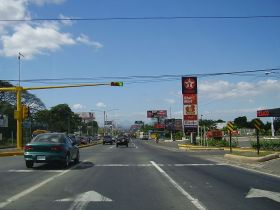What are the main cities, towns, communities and developments of the Managua, Nicaragua area and what is each one like?
Kent Payne
In Nicaragua you have the city of  Managua, which is the capital city, and there are several large towns like Leon, Granada, and San Juan del Sur. The country is also dived into what we call “areas” or “departments”, which are like “states” in the US.
Managua, which is the capital city, and there are several large towns like Leon, Granada, and San Juan del Sur. The country is also dived into what we call “areas” or “departments”, which are like “states” in the US.
For example, speaking specifically about “Managua”, at Gran Pacifica, we live in the Department of Managua, but not in the city of Managua. Still, we say that we “live in...
 Managua, which is the capital city, and there are several large towns like Leon, Granada, and San Juan del Sur. The country is also dived into what we call “areas” or “departments”, which are like “states” in the US.
Managua, which is the capital city, and there are several large towns like Leon, Granada, and San Juan del Sur. The country is also dived into what we call “areas” or “departments”, which are like “states” in the US.For example, speaking specifically about “Managua”, at Gran Pacifica, we live in the Department of Managua, but not in the city of Managua. Still, we say that we “live in...
In Nicaragua you have the city of  Managua, which is the capital city, and there are several large towns like Leon, Granada, and San Juan del Sur. The country is also dived into what we call “areas” or “departments”, which are like “states” in the US.
Managua, which is the capital city, and there are several large towns like Leon, Granada, and San Juan del Sur. The country is also dived into what we call “areas” or “departments”, which are like “states” in the US.
For example, speaking specifically about “Managua”, at Gran Pacifica, we live in the Department of Managua, but not in the city of Managua. Still, we say that we “live in Managua”, even though we live 42 miles away from the city of Managua, on the Pacific Ocean, about an hour away by car, in a very sparsely populated area.
Here are the key places in the Department of Managua:
 Managua, which is the capital city, and there are several large towns like Leon, Granada, and San Juan del Sur. The country is also dived into what we call “areas” or “departments”, which are like “states” in the US.
Managua, which is the capital city, and there are several large towns like Leon, Granada, and San Juan del Sur. The country is also dived into what we call “areas” or “departments”, which are like “states” in the US.For example, speaking specifically about “Managua”, at Gran Pacifica, we live in the Department of Managua, but not in the city of Managua. Still, we say that we “live in Managua”, even though we live 42 miles away from the city of Managua, on the Pacific Ocean, about an hour away by car, in a very sparsely populated area.
Here are the key places in the Department of Managua:
Gran Pacifica
Gran Pacifica would be considered a town unto itself. We have 2,500 acres, which is enough to build about 5,000 residences. This means that, 20 – 25 years from now, if you assume two people per residence, we could have as many as 10,000 people living in our little city.
Even though we live in the Department of Managua, we certainly don’t have the same negative noise pollution, chickens, honking taxis, buses running over motorcyclists, etc. at Gran Pacifica that the city of Managua does. We have a much more relaxing, bucolic lifestyle. As we say in our world, it’s “muy tranquilo”.
At Gran Pacifica, we don’t allow the chickens and pigs to be in the property. You can have a farm but it has to be offsite and we don’t allow for walls and razor wires because it is not necessary. We have 24/7 security, both at our gate and inside the property, not to keep people out, even if you would think that’s what security is for, but the truth is it’s a deterrent. That way, we don’t generally have any issues and we have a way of handling issues that may pop up.
If you live at Gran Pacifica and need the big city stuff, its 42 miles away in the city of Managua; a little less than an hour drive away.
Villa El Carmen
Villa El Carmen is a little town we’re close to, which has our municipality in it. Our police services and some health care are in Villa El Carmen, which is only about 15-20 minutes away from Gran Pacifica. Villa El Carmen is a good example of other places like it in the Department of Managua.
Main City of Managua
Managua is the capital city of Nicaragua. Its population of 1.3 million is just under 1/3 of the entire 5.5 million population of the country of Nicaragua.
In 1972, the central city fell into the lake. They had an earthquake that killed over 10,000 people, mostly because the construction was so poor that when the earthquake hit, most of the big buildings came down. So now the governmental buildings are spread out all across the city, with different departments in different areas.
After the earthquake in 1972, there is a ramshackle way of reconstructing the city of Managua itself, so there is no central location. The Metro Centro is the metropolitan part of the center of Managua. It has a couple of shopping centers and a couple of the international hotels. But from there, the nicer shopping is on the outskirts, where since the 70’s the growth has come, mostly going south or going west coming out towards Gran Pacifica.
When you fly into Managua, you fly over what we call the North Highways. Actually, the North Highway area is on the far east side of the town but the highway runs north and south, so they call it the North Highway.
It’s about a 15-20 minute drive across the town of Managua itself and you pass through what we call “barrios". That word has a negative connotation in the States, but here, it just means "neighborhoods".
For the most part, along the main highways are the main roads. As you might imagine, there are commercial areas there – one guy has a mattress shop, next door to an ironworker who makes charcoal grills. As you drive through this part of town you can stop and make purchases. You can buy hammocks, you can buy cloth from the fabric store, etc. People usually live behind their places of business like they used to in the 20’s, back in the States.
As you go across the town of Managua, you find neighborhoods that are extremely crowded, even at night. I’ve come in on late night flights and driven across town and it’s amazing to me how active these towns are until 11:30 at night to one o’clock in the morning. Yet at 4:30 in the morning, just about dawn, you have people who are walking to work or taking a jog. Because of the heavy traffic, you'll also find what I’m going to consider noise pollution.
I stayed in one of the nicer subdivisions called Santo Domingo, which is up on a hill, near the church of Santo Domingo. And every morning, starting about 4 AM, the roosters started crowing because there are no covenants or government restrictions in a town like that. You can see pig farms right next to US $850,000 mansions, and all of them have walls with razor wires on the top.
Posted September 3, 2014
Frank Martínez
 The first thing you will see once your plane lands in the airport in Managua is a city spread along a beautiful lake. From the plane, you will not see buildings in Managua because we do not have a lot of very tall buildings. (Masaya Market, pictured.) We only have about 7 tall buildings in Managua. About 99% of the houses in Managua are single-story houses, so what you will see from the plane is a big blanket of green, which is due to the many trees and natural parks in Managua....
The first thing you will see once your plane lands in the airport in Managua is a city spread along a beautiful lake. From the plane, you will not see buildings in Managua because we do not have a lot of very tall buildings. (Masaya Market, pictured.) We only have about 7 tall buildings in Managua. About 99% of the houses in Managua are single-story houses, so what you will see from the plane is a big blanket of green, which is due to the many trees and natural parks in Managua.... The first thing you will see once your plane lands in the airport in Managua is a city spread along a beautiful lake. From the plane, you will not see buildings in Managua because we do not have a lot of very tall buildings. (Masaya Market, pictured.) We only have about 7 tall buildings in Managua. About 99% of the houses in Managua are single-story houses, so what you will see from the plane is a big blanket of green, which is due to the many trees and natural parks in Managua. It is beautiful. You will see Lake Managua to the north of the city and the mountains to the south of the city. Managua is like a valley.
The first thing you will see once your plane lands in the airport in Managua is a city spread along a beautiful lake. From the plane, you will not see buildings in Managua because we do not have a lot of very tall buildings. (Masaya Market, pictured.) We only have about 7 tall buildings in Managua. About 99% of the houses in Managua are single-story houses, so what you will see from the plane is a big blanket of green, which is due to the many trees and natural parks in Managua. It is beautiful. You will see Lake Managua to the north of the city and the mountains to the south of the city. Managua is like a valley. Traffic is not bad at all here in Managua. We only have traffic during peak times: 7 AM to 8 AM, then from 5 PM to 7 PM. But most of the times traffic is very fluid. In Managua, you will not see the traffic jams that you see in the US or in other countries like Costa Rica, where the traffic is very savage because of thousands of cars. We do not have a traffic problem here in Managua.
Another thing that will catch your attention is the beauty of the sky; it is always blue. There is always sunshine. The average temperature here in Managua is between 29 to 33 degrees Celsius (84 to 91 Fahrenheit) for the whole year. If you are sick and you need a place to go to regain your health, you can go to Managua, since we do not have air pollution here. We rarely see buses that emit bad smoke.
The weather is sunshiny and it is always nice here in Managua.
Managua does not really have a downtown because the city has spread out without control. People built malls and shopping centers just anywhere because there is no zoning regulation. Managua has a central highway called Caretera Masaya, which is where all major offices and three big malls are. The name of the town is the same as the name of the highway because Managua is a small town, so we do not have many different places. Caretera Masaya is the most visited and has the highest traffic here in Managua. Everyone wants to build their businesses there. You can find anything you would be looking for in Caretera Masaya. It is a very iconic highway in Managua.
Managua is sitting next to Lake Managua. The terrain goes upward from the lake so the farther you go from the lake, the higher the ground is and you will find yourself surrounded by little and big mountains. The middle and upper class live in the higher areas. They prefer to be away from the center of Managua on higher ground, where the weather is cooler. That is where the urban developments take place. You will see the highest urban developments in Caretera Masaya. It has been that way for several years. It has the highest percentage of new houses.
Managua is located about an hour away from the beach developments in the Pacific coast. San Juan Del Sur, which is one of the best beach communities in Nicaragua, is about two hours away from Managua. San Juan Del Sur is the farthest beach community from Managua and it is not even that far. Other beach communities are relatively close, so if you are in Managua, you can go to the beach anytime. The Pacific coast has new highways. It makes travel so much easier. It only takes about 5 hours to drive from the Costa Rican border to the Honduran border.
Posted December 22, 2014
Immanuel Zerger - Solentiname Tours - Discover Nicaragua
 There are several different neighborhoods in Managua.
There are several different neighborhoods in Managua. The houses in Managua are mostly single-story, which were practically the only ones built from 1972 to the 2000s. This is the reason why Managua is very spread out; we have lots of single-story homes, instead of high-rise buildings. If you don’t have a car, it is difficult to get around Managua.
Some hotels and the big financial groups of the country built some...
 There are several different neighborhoods in Managua.
There are several different neighborhoods in Managua. The houses in Managua are mostly single-story, which were practically the only ones built from 1972 to the 2000s. This is the reason why Managua is very spread out; we have lots of single-story homes, instead of high-rise buildings. If you don’t have a car, it is difficult to get around Managua.
Some hotels and the big financial groups of the country built some 5-story buildings in the 2000s. There are barrios near Lake Nicaragua and there are older neighborhoods with some businesses mixed in with private housing areas. When you go up into the hills, where there is more fresh air, you will see some condominiums, larger private properties, and mansions that are really fancy. Along the two main roads going to the south of Managua (Carretera Sur and Carretera Masaya), there are higher quality living areas.

The National Theater Ruben Dario is also in Managua (pictured). Ruben Dario was a Nicaraguan writer and hero who reformed the Spanish language in the 19th century. For this reason he is also recognized in Spain, where there is even a metro station named after him. The National Theater Ruben Dario is the center for cultural activities and where choirs, orchestras, staff musicals, and national and international presentations are performed. Also located in Managua is the National Culture Palace, which holds exhibitions and has a museum of human history and nature of Nicaragua.
There is also a new and fancy area at Lake Nicaragua called Port Salvador Allende. There is a cruise ship there that takes people on a tour of Lake Nicaragua . You can have a beautiful night tour on the lake and you have a wide variety of restaurants from which to choose.
Posted January 26, 2015


